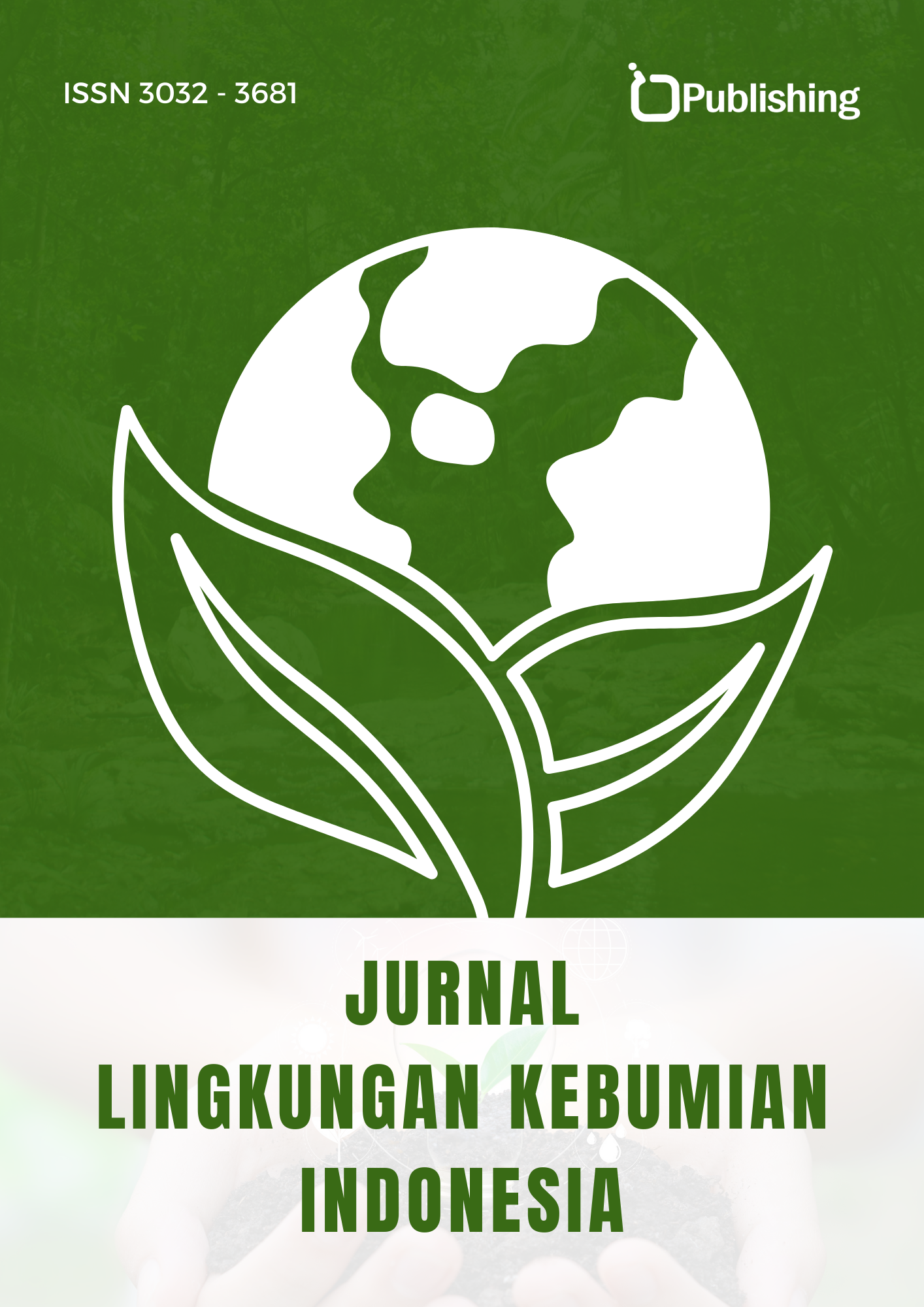Utilization of Bioindicators in Environmental Biomonitoring: A Comprehensive Review
DOI:
https://doi.org/10.47134/kebumian.v1i1.2064Keywords:
Biomonitoring, Quality, EnvironmentAbstract
Environmental biomonitoring is the latest branch of science in modern environmental science. The concept allows the monitoring of environmental quality by involving the use of organisms as a measure of contamination levels. This comprehensive review showcases the latest advances in the field of environmental science with emphasis on innovative methodologies, technological breakthroughs and implications for environmental understanding and management. The review discusses the types of bioindicators that have been used and their respective benefits. Rapid monitoring of environmental quality through biomonitoring helps equip policy makers and stakeholders with critical data and facilitates evidence-based decision making. Further research in this field is needed as it can be a feasible alternative to rapid, low-cost and practical environmental monitoring.
References
Aslan, A. dkk. (2013). Evaluation of Lichens as Bioindicator of Metal Pollution. Journal of Elementology, 18(3): 353-369.
Azal, B. (2022). The role of biotic and abiotic components in biodiversity. Global Science Research Journals, 1(1): 1-2.
Biase, L., D., dkk. (2022). Use of Lichens to Evaluate the Impact of Post-Earthquake Reconstruction Activities on Air Quality: A Case Study from the City of L’Aquila. MDPI, 11: 1-14. DOI: https://doi.org/10.3390/biology11081199
Burger, J. (2006). Biondicators: A Review of Their Use in the Environmental Literature 1970-2005. Environmental Bioindicators, 1: 136-144. DOI: https://doi.org/10.1080/15555270600701540
Burger, J., dkk. (2012). Selenium: Mercury Molar Ratios in Freshwater Fish from Tennese: Individual, Species and Geographical Variations have Implications for Management. Ecohealth, 9(2) :171-182. DOI: https://doi.org/10.1007/s10393-012-0761-y
Cobo-Simón, I., Méndez-Cea, B., Portillo, H., Elvir, F., Vega, H., Gallego, F., … & Fontecha, G. (2019). Testing the effectiveness of conservation management within biosphere reserves: the case of the mexican deer mouse (peromyscus mexicanus) as a bioindicator. Integrative Zoology, 14(5), 422-434. DOI: https://doi.org/10.1111/1749-4877.12371
Dahlgaard, H. (1981). Bioindicators for monitoring radioactive pollution of the marine environment. Risoe National Lab Roskilde: Denmark.
Das, S. dan Pattanayak, S. (2020). Bioindicator Emerged as a Potential Environmental Marker. International Journal of Agriculture Environment and Biotechnology, 13(3): 339-344. DOI: https://doi.org/10.30954/0974-1712.03.2020.9
David, T. (1989). Bio-indicator in air pollution research. Application and Constraints biologic markers of air pollution stress and damage in forests. Washington, DC: Nation Academics Press, 73–80.
Ferdous, Z. dan Muktadir, A.K.M. (2009). A Review: Potentiality of Zooplankton as Bioindicator. American Journal of Applied Sciences, 6(10): 1815-1819. DOI: https://doi.org/10.3844/ajassp.2009.1815.1819
Forbes SA (1887) The lake as a microcosm. Bull Sci Assoc, Peoria, IL, 1887, S. 77–87, wiederveröffentlicht. Illinois Nat Hist Survey Bulletin, 15/9/Jahrgang, S. 537–550. DOI: https://doi.org/10.21900/j.inhs.v15.303
Gadzala-Kopiuch, R., dkk. (2004). Some Considerations About Bioindicators in Environmental Monitoring. Polish Journal of Environmental Studies, 13(5): 453-462.
Herrera-Duenas, A. dkk. (2014). Oxidative stress of House Sparrow as bioindicator of urban pollution. Ecological Indicators, 42: 6-9. DOI: https://doi.org/10.1016/j.ecolind.2013.08.014
Kolkwitz, R., Marsson, M. (1902) Grundsätze für die biologische Beurteilung des Wassers nach seiner Flora und Fauna. Mitt. Aus d. Kgl. Prüfungsanstalt für Wasserversorgung u. Abwasserbeseitigung Berlin 1:33–72.
Kushlan, J. A. (1993). Colonial Waterbirds as Bioindicators of Environmental Change. Colonial Waterbirds, 16(2): 223-251. DOI: https://doi.org/10.2307/1521444
Li, Y., Wu, J., Chen, H., & Chen, J. (2005). Nematode as bioindicator of soil health: methods and applications. The journal of applied ecology, 16(8), 1541–1546.
Macali, A. dan Bergami, E. (2020). Jellyfish as innovative bioindicator for plasiic pollution. Ecological Indicators, 115, 1-8. DOI: https://doi.org/10.1016/j.ecolind.2020.106375
Miller, P., R., dkk. (1996). Evaluating Ozone Air Pollution Effects on Pines in the Western United States. California: Pacific Southwest Research Station. DOI: https://doi.org/10.2737/PSW-GTR-155
Moncehva, S. (2012). Rapana Venosa as a Bioindicator of Environmental Pollution. Chemistry and Ecology, 27(1): 31-41. DOI: https://doi.org/10.1080/02757540.2010.522996
Montuelle, B.dkk. (2010). The periphyton as a multimetric bioindicator for assessing the impact of land use on rivers: an overview of the Ardieres-Morcille Experimental Watershed (France). Global Change and River Ecosystems, 657: 123-141. DOI: https://doi.org/10.1007/s10750-010-0105-2
Olivira, R. C. D., dkk. (2016). Bee Pollen as a Bioindicator of Environmental Pesticide Contamination. Chemosphere, 163:525-534. DOI: https://doi.org/10.1016/j.chemosphere.2016.08.022
Pollet, I. dan Bendell-Young, L. I. (2000). Amphibians as Indicators of Wetland Quality in Wetlands Formed from Oil Sands Effluent. Environmental Toxicology and Chemistry, 19(1): 2589-2597. DOI: https://doi.org/10.1002/etc.5620191027
Prihastanti, E., Hastuti. E. D. dan Haryati, S. (2023). Determination of proline content and NPK resorption of mangrove leaves as adaptive bioindicators of environmental change. AIP Conference Proceedings 2 June 2023; 2738 (1): 040022. DOI: https://doi.org/10.1063/5.0140268
Puspitasari, R., dkk. (2018). Short time effect of cadmium and copper on java medaka (Oryzias javanicus) as bioindicator for ecotoxicological studies. IC3PE, 2026: 1-5. DOI: https://doi.org/10.1063/1.5064975
Rainio, J. and Niemela, J. (2003). Ground beetles (Coleoptera: Carabidae) as bioindicators. Biodiversity and Conservation, 12(3): 487-506. DOI: https://doi.org/10.1023/A:1022412617568
Reynolds, J.W. (2001). The Earthworms of South Carolina. Megadrilogica, 8(7): 25-36.
Rosa Marín, A. Benthic foraminifera as bioindicators of coral reef health. Nat Rev Earth Environ (2023). DOI: https://doi.org/10.1038/s43017-023-00451-8
Russo, D. dan Jones, G. (2015). Bats as bioimdicators: An Introduction. Mammalian Biology, 486 (3): 1-5. DOI: https://doi.org/10.1016/j.mambio.2015.03.005
Sievers, A., Wenz, F., Hausmann, M., & Hildenbrand, G. (2018). Conservation of k-mer composition and correlation contribution between introns and intergenic regions of animalia genomes. Genes, 9(10), 482. DOI: https://doi.org/10.3390/genes9100482
Singh, P., Singh, S., dan Silanpaa, M. (2022). Pesticide in the Natural Environment. Elsevier.
Teta, R., dkk. (2019). Bioindicators as a Tool in Environmental Impact Assesment: Cyanobacteria as a Sentinel Pollution. International Journal of Sustainable Development and Planning., 3(1): 19-26. DOI: https://doi.org/10.2495/SDP-V14-N1-1-8
Ueno, D., dkk. (2004). Global Pollution Monitoring of Polybrominated Diphenyl Ethers Using Skipjack Tuna as a Bioindicator. Enviromental Science & Techonolgy 38: 2312-2316. DOI: https://doi.org/10.1021/es035323k
Downloads
Published
How to Cite
Issue
Section
License
Copyright (c) 2023 Meilyn Misya, Johan Danu Prasetya

This work is licensed under a Creative Commons Attribution 4.0 International License.






